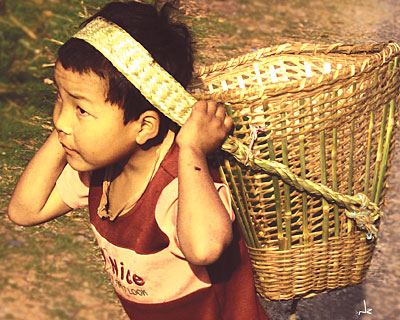 |
From glass-slippered Cinderella to Harry Potter, folklore from across the world has maintained that just about the worst thing that can happen to a child is separation from its parents. Thirteen-year-old Kumar had to endure an even worse fate when he was whisked away from his village in Ramechhap to look after someone else's children. A whole school of them.
Kumar is the youngest employee at a private school in Lalitpur. Tall and scrawny, Kumar and his oversized t-shirts are a regular fixture in the neighbourhood as he starts his day running errands for his sahuni. He then travels on the school bus helping young children get on and off. Most afternoons he can be seen by an outdoor tap near his building � washing and cleaning. With few friends and hardly any time to play, the quiet boy trudges from one task to another like a zombie as his sahuni watches.
The difference between what Kumar's life should be and what it is presently is all the more stark for his placement at a school that is meant to help young people explore their potential.
Except Kumar's. Unless you believe people should be bred to wash dishes and serve tea. The children at the school, whose bus he washes everyday, go on to become doctors, teachers and artists, while his capabilities have been deliberated capped by his sahuni. It's not just him. According to ILO and children's NGOs, there are 50,000 domestic children workers in Nepal and an additional 1.6 million child labourers in other sectors, which adds up to 26.6 per cent of the total population of children in Nepal � all of them wasted human potential caught in the multi-generational cycle of child labour.
Complicity in the idea that it is the bad luck of children like Kumar that is to blame for their situation makes any changes in their lives tricky. Childcare workers say a majority of people that employ them think they are actually helping the children in their charge, making child employment less of a stigma. The operating principle of "at least they are getting fed" overlooks all other needs over and above basic physical needs.
Research shows such children are less happy than their counterparts from the same income group. Kumar may be 3,500 rupees a month better off than his friends in Ramechhap, but he is by no means happier. Child Workers in Nepal (CWIN), a children's organisation that runs a child helpline and carries out interventions to rescue children from risky work environments, says that children rehabilitated with their parents with their support show remarkable changes in their outlook.
After running an intervention, CWIN supports children to prevent them from "being a burden to the family". As child labour is the direct result of parental poverty, some childcare workers argue that a blanket ban on child labour should be matched with wage increments for the adult workforce and assistance to others. That would prevent children from being employed in a waged market because they can be paid less.
The first step to reversing the trend is to call child labour by its correct name and to recognise that continuing subordination also has an impact on the future of the nation and its economy. They are like the plants that grow in your garden. You don't imagine they will remain scrawny near-dead stalks, but you feed them and water them and hope for them. It is not easy but it is not a task for supernatural fairies either. You just need a little common sense and whole lot of compassion to turn an old chappal into a glass slipper.
READ ALSO:
Ecosystem Nepal, ASHUTOSH TIWARI
Valley belly, BUDDHA BASNYAT



